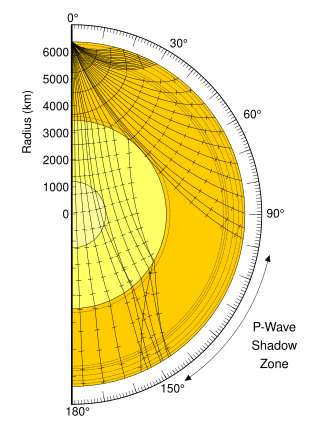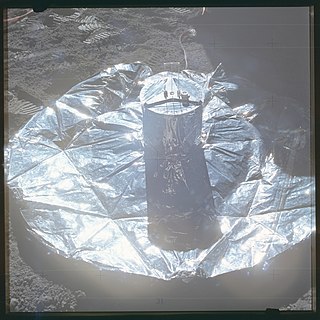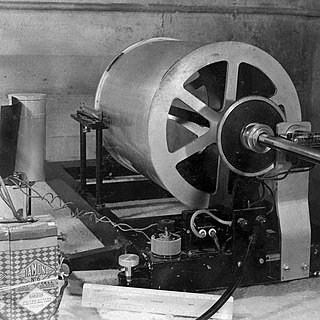
Seismology is the scientific study of earthquakes and the generation and propagation of elastic waves through the Earth or other planetary bodies. It also includes studies of earthquake environmental effects such as tsunamis as well as diverse seismic sources such as volcanic, tectonic, glacial, fluvial, oceanic microseism, atmospheric, and artificial processes such as explosions and human activities. A related field that uses geology to infer information regarding past earthquakes is paleoseismology. A recording of Earth motion as a function of time, created by a seismograph is called a seismogram. A seismologist is a scientist working in basic or applied seismology.

A seismometer is an instrument that responds to ground noises and shaking such as caused by quakes, volcanic eruptions, and explosions. They are usually combined with a timing device and a recording device to form a seismograph. The output of such a device—formerly recorded on paper or film, now recorded and processed digitally—is a seismogram. Such data is used to locate and characterize earthquakes, and to study the Earth's internal structure.
Seismic tomography is a technique for imaging the subsurface of the Earth with seismic waves produced by earthquakes or explosions. P-, S-, and surface waves can be used for tomographic models of different resolutions based on seismic wavelength, wave source distance, and the seismograph array coverage. The data received at seismometers are used to solve an inverse problem, wherein the locations of reflection and refraction of the wave paths are determined. This solution can be used to create 3D images of velocity anomalies which may be interpreted as structural, thermal, or compositional variations. Geoscientists use these images to better understand core, mantle, and plate tectonic processes.

IRIS was a university research consortium dedicated to exploring the Earth's interior through the collection and distribution of seismographic data. IRIS programs contributed to scholarly research, education, earthquake hazard mitigation, and the verification of a Comprehensive Nuclear-Test-Ban Treaty. Support for IRIS came from the National Science Foundation, other federal agencies, universities, and private foundations. IRIS supported five major components, the Data Management Center (DMC), the Portable Array Seismic Studies of the Continental Lithosphere (PASSCAL), the Global Seismographic Network (GSN), the Transportable Array (USARRAY), and the Education and Public Outreach Program (EPO). IRIS maintained a Corporate Office in Washington, DC.

The 1970 Ancash earthquake occurred on 31 May off the coast of Peru in the Pacific Ocean at . Combined with a resultant landslide, it is the most catastrophic natural disaster in the history of Peru. Due to the large amounts of snow and ice included in the landslide that caused an estimated 66,000-70,000 casualties, it is also considered to be the world's deadliest avalanche.

The EarthScope project was an National Science Foundation (NSF) funded earth science program that, from 2003-2018, used geological and geophysical techniques to explore the structure and evolution of the North American continent and to understand the processes controlling earthquakes and volcanoes. The project had three components: USArray, the Plate Boundary Observatory, and the San Andreas Fault Observatory at Depth. Organizations associated with the project included UNAVCO, the Incorporated Research Institutions for Seismology (IRIS), Stanford University, the United States Geological Survey (USGS) and National Aeronautics and Space Administration (NASA). Several international organizations also contributed to the initiative. EarthScope data are publicly accessible.

A marsquake is a quake which, much like an earthquake, would be a shaking of the surface or interior of the planet Mars as a result of the sudden release of energy in the planet's interior, such as the result of plate tectonics, which most quakes on Earth originate from, or possibly from hotspots such as Olympus Mons or the Tharsis Montes. The detection and analysis of marsquakes could be informative to probing the interior structure of Mars, as well as identifying whether any of Mars's many volcanoes continue to be volcanically active.

Lunar seismology is the study of ground motions of the Moon and the events, typically impacts or moonquakes, that excite them.
In geophysics, geology, civil engineering, and related disciplines, seismic noise is a generic name for a relatively persistent vibration of the ground, due to a multitude of causes, that is often a non-interpretable or unwanted component of signals recorded by seismometers.
An ocean-bottom seismometer (OBS) is a seismometer that is designed to record the earth motion under oceans and lakes from man-made sources and natural sources.

The National Seismological Center of the University of Chile is part of the Department of Physical and Mathematical Sciences at the University of Chile. The center collects information about seismic activity in Chile and delivers it to the National Office of Emergency at the Ministry of the Interior (ONEMI) and the Hydrographic and Oceanographic Service of the Chilean Navy (SHOA). The current director of the CSN is Sergio Barrientos Parra. The National Seismological Center is housed by the Department of Geophysics (DGF).

The Seismic Experiment for Interior Structure (SEIS) is a seismometer and the primary scientific instrument on board the InSight Mars lander launched on 5 May 2018 for a landing on 26 November 2018; the instrument was deployed to the surface of Mars on 19 December. SEIS is expected to provide seismic measurements of marsquakes, enabling researchers to develop 3D structure maps of the deep interior. Better understanding the internal structure of Mars will lead to better understanding of the Earth, Moon, and rocky planetary bodies in general.
Miaki Ishii is a seismologist and Professor of Earth and Planetary Sciences at Harvard University.
Frederik J. Simons is a Flemish Belgian geophysicist. He is a professor at Princeton University in the Department of Geosciences. From 2010 to 2013, Simons was the Dusenbury University Preceptor of Geological & Geophysical Sciences. From 2004 to 2006, he was a lecturer in the Department of Earth Sciences at University College London. Between 2002 and 2004 he was a Harry H. Hess Postdoctoral Fellow in the Department of Geosciences and a Beck Fellow with the Council on Science and Technology, also at Princeton University.
Galperin configuration are a particular configuration of sensing elements found in a class of seismic instruments measuring ground motion and are named after Soviet seisomologist Evsey Iosifovich Galperin, who introduced it in 1955 for petroleum exploration.
Anne Meltzer is a seismologist known for her research on earthquakes and the formation of mountain ranges. Her research primarily focused on the evolution of the Earth's lithosphere and the surface processes associated with faulting and deformation in the Earth's crust. Through her own personal research and collaboration with other colleagues, she strived to make advancements in the efficiency and effectiveness of monitoring earthquakes. In addition, her work aimed to effectively reduce earthquake destruction in countries that experience frequent seismic phenomena.
Anne Sheehan is a geologist known for her research using seismometer data to examine changes in the Earth's crust and mantle.
Fluvial seismology is the application of seismological methods to understand river processes, such as discharge, erosion, and streambed evolution. Flowing water and the movement of sediments along the streambed generate elastic (seismic) waves that propagate into the surrounding Earth materials. Seismometers can record these signals, which can be analyzed to illuminate different fluvial processes such as turbulent water flow and bedload transport. Seismic methods have been used to observe discharge values that range from single-digits up through tens of thousands of cubic feet per second (cfs).

The Wood–Anderson seismometer is a torsion seismometer developed in the United States by Harry O. Wood and John August Anderson in the 1920s to record local earthquakes in southern California. It photographically records the horizontal motion. The seismometer uses a pendulum of 0.8g, its period is 0.8 seconds, its magnification is 2,800 times, and its damping constant is 0.8. Charles Francis Richter developed the Richter magnitude scale using the Wood–Anderson seismometer.
Subsurface mapping by ambient noise tomography is the mapping underground geological structures under the assistance of seismic signals. Ambient noise, which is not associated with the earthquake, is the background seismic signals. Given that the ambient noises have low frequencies in general, the further classification of ambient noise include secondary microseisms, primary microseisms, and seismic hum, based on different range of frequencies. We can utilize the ambient noise data collected by seismometers to create images for the subsurface under the following processes. The filtered ambient noise raw data Since the ambient noise is considered as diffuse wavefield, we can correlate the filtered ambient noise data from a pair of seismic stations to find the velocities of seismic wavefields. A 2-dimensional or 3-dimensional velocity map, showing the spatial velocity difference of the subsurface, can thus be created for observing the geological structures. Subsurface mapping by ambient noise tomography can be applied in different fields, such as detecting the underground void space, monitoring landslides, and mapping the crustal and upper mantle structure.












